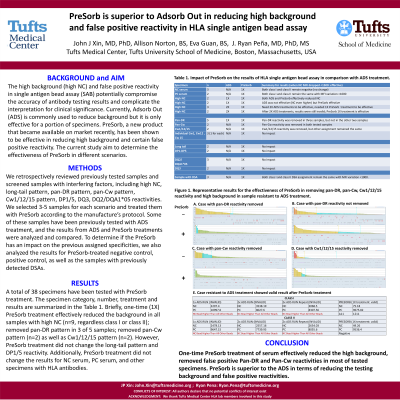Back

(P718) PreSorb is superior to Adsorb Out in reducing high background and false positive reactivity in HLA single antigen bead assay
Location: Platinum Ballroom

Poster Presenter(s)
Aim: The high background (high NC) and false positive reactivity in single antigen bead assay (SAB) potentially compromise the accuracy of antibody testing results and complicate the interpretation for clinical implication. Currently, Adsorb Out (ADS) is commonly used to reduce background but it is only effective for a portion of specimens. PreSorb became available recently and has been claimed to be effective in reducing high background and certain false positive reactivity. The current study aim: to determine the effectiveness of PreSorb in different scenarios.
Method: We retrospectively reviewed previously tested samples and screened samples with interfering factors, including high NC requiring ADS treatment, long-tail pattern, pan-DR pattern, pan-Cw pattern, Cw1/12/15 pattern, DP1/5, DQ3, DQ2/DQA1*05 reactivities. We selected 3-5 samples for each scenario and treat them with Pre-Sorb according to the manufacture’s protocol. The results from ADS and PreSorb treatments were analyzed and compared. To determine if the Pre-Sorb has an impact on the previous assigned specificities, we also analyzed the results for PreSorb-treated negative control, positive control, as well as the samples with previously detected DSAs.
Results: A total of 38 specimens have been tested with PreSorb treatment. The specimen category, number, treatment and results are summarized in the Table 1. Briefly, one-time (1X) PreSorb treatment effectively reduced the background in all samples with high NC (n=9, regardless class I or class II); removed pan-DR reactivity in 3 of 5 samples; removed pan-Cw reactivity (n=2) as well as Cw1/12/15 reactivity (n=2). However, PreSorb treatment did not change the long-tail pattern and DP1/5 reactivities. Additionally, PreSorb treatment did not change the results for NC serum, PC serum, and other specimens with HLA antibodies.
Conclusion: One-time PreSorb treatment of serum specimen effectively reduced the high background in all tested samples, which otherwise required one or multiple ADS treatments but might be resistant to ADS treatment. Additionally, PreSorb was capable of removing false positive Pan-DR and Pan-Cw reactivities in most of tested specimens. Furthermore, PreSorb appeared to have no impact on the detection of real antibodies and did not introduce false positive reactivity. PreSorb is superior to the ADS in terms of reducing the testing background.
Method: We retrospectively reviewed previously tested samples and screened samples with interfering factors, including high NC requiring ADS treatment, long-tail pattern, pan-DR pattern, pan-Cw pattern, Cw1/12/15 pattern, DP1/5, DQ3, DQ2/DQA1*05 reactivities. We selected 3-5 samples for each scenario and treat them with Pre-Sorb according to the manufacture’s protocol. The results from ADS and PreSorb treatments were analyzed and compared. To determine if the Pre-Sorb has an impact on the previous assigned specificities, we also analyzed the results for PreSorb-treated negative control, positive control, as well as the samples with previously detected DSAs.
Results: A total of 38 specimens have been tested with PreSorb treatment. The specimen category, number, treatment and results are summarized in the Table 1. Briefly, one-time (1X) PreSorb treatment effectively reduced the background in all samples with high NC (n=9, regardless class I or class II); removed pan-DR reactivity in 3 of 5 samples; removed pan-Cw reactivity (n=2) as well as Cw1/12/15 reactivity (n=2). However, PreSorb treatment did not change the long-tail pattern and DP1/5 reactivities. Additionally, PreSorb treatment did not change the results for NC serum, PC serum, and other specimens with HLA antibodies.
Conclusion: One-time PreSorb treatment of serum specimen effectively reduced the high background in all tested samples, which otherwise required one or multiple ADS treatments but might be resistant to ADS treatment. Additionally, PreSorb was capable of removing false positive Pan-DR and Pan-Cw reactivities in most of tested specimens. Furthermore, PreSorb appeared to have no impact on the detection of real antibodies and did not introduce false positive reactivity. PreSorb is superior to the ADS in terms of reducing the testing background.

